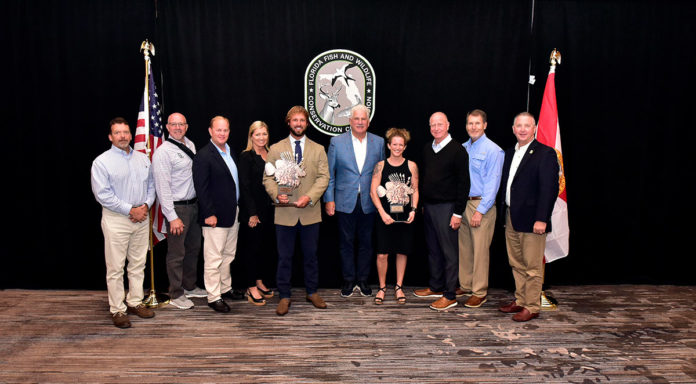
For most people, 700 pounds of fish constitutes a monstrous bounty from the sea. But for the 2021 commercial Lionfish Challenge champion Rachel Bowman, it’s “not my best year.”
At their October meeting, the Florida Fish and Wildlife Conservation Commission (FWC) honored the winners of the 2021 Lionfish Challenge. Now in its sixth year, the program incentivizes removal of the venomous, invasive Indo-Pacific fish for both recreational and commercial harvesters. A free contest, the challenge offers prizes for winners, automatic rewards for reaching set lionfish removal goals, raffle drawings, and even the chance to earn tokens used to harvest an extra spiny lobster during mini season.
As this year’s commercial champion (and first-ever female winner) with 730 pounds of lionfish removed in 2021 alone, Bowman sees the challenge — and lionfish harvesting in general — as a financial and ecological win. Introduced to Caribbean waters, the venomous fish have no consistent natural predators, a high reproductive rate and a damaging effect on local fish and crustacean populations. So when Bowman dives on her many hotspots in the Gulf of Mexico, complete eradication is her top priority. “If I get there and the spot’s loaded, that’s great for my bank account,” she says. “And if it’s empty, that’s great for the environment.”
According to Amanda Nalley, FWC’s public information specialist for marine fisheries, the example set by Bowman and others has made more people aware of the lionfish problem. “I’m really excited for Rachel,” said Nalley, also a longtime friend of Bowman’s. “She’s been such an inspiration to many with her involvement. She’s been so involved from the beginning, and she deserves it.”
Bowman prefers to dive in Florida’s panhandle, where many isolated artificial structures yield high fish densities. She explains the differences between Keys diving and the waters of the panhandle with a perfect analogy. “When we go up there, it’s like scooping change out of a mall fountain. When we dive down here, we’re looking for loose coins under cars in the parking lot.”
Although she is a commercial harvester, Bowman always has the environmental roots of the competition on her mind. It would be easy to harvest large fish while leaving smaller individuals to keep a site stocked for future trips, but she is strongly opposed to this practice. “If I find a spot with lionfish on it, you won’t find them when you go there.”
Once harvested, she sells the fish to local restaurants or to Whole Foods, the company that gave her her first sale in May 2016. Before the business took an interest in the fish, Bowman said, sales were low and usually netted only $2 to $3 per pound. In the years since, the value of the fish has increased significantly. “They added validity to what we’re doing,” she said. Ironically, Bowman also now works as a bartender for one of Whole Foods’ largest seafood distributors: Keys Fisheries.
As individuals and businesses increase the demand for the white, flaky fish (and stop confusing them with potentially poisonous pufferfish), Bowman said, many harvesters are anecdotally observing declining populations. However, there seem to be other factors at play. “I would love to say it’s because of divers and lobster traps, but it isn’t,” she says.
While these factors certainly help, she also points to an ulcerative skin disease that emerged in late 2017. According to a 2020 Scientific Reports paper, remotely operated vehicle surveys of natural reefs in the northern Gulf of Mexico from 2016 to 2018 indicated a 75% population decline on natural reefs in 2018. This comes following a period in August 2017 when an estimated 40% of all studied fish were affected by the disease.
As the disease causes open lesions on affected fish, it has proved difficult to study. The open wounds are instantly flooded with saltwater, making it extremely challenging for researchers to retrieve clean tissue or bacterial samples from visibly affected fish.
Research on the disease is ongoing, but regardless, Bowman’s 2021 commercial championship comes in a year when declining populations added an increasing layer of difficulty to the task. But in her mind, if that’s an indication of an invasive species’ decline, that’s just fine. “It’s the boom-and-bust ecology of an invasive species,” she says. “We have a species that isn’t supposed to be here and has us all worried, but the environment is pitching in a little bit to help us out.”


























